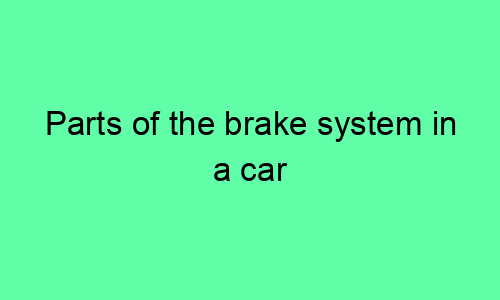Parts of the Brake System in a Car
Master Cylinder
The master cylinder is the central component of the brake system. It converts the force applied to the brake pedal into hydraulic pressure, which is then distributed to the wheels.
Brake Lines
Brake lines are the tubes that carry hydraulic fluid from the master cylinder to the wheels. They are typically made of steel or rubber, and are designed to withstand the high pressures generated by the brake system.
Brake Calipers
Brake calipers are the devices that clamp down on the brake rotors to slow down or stop the car. They are typically made of cast iron or aluminum, and contain pistons that are actuated by hydraulic pressure from the master cylinder.
Brake Rotors
Brake rotors are the discs that are attached to the wheels and are clamped down on by the brake calipers. They are typically made of cast iron or steel, and have a series of slots or holes to dissipate heat.
Brake Pads
Brake pads are the friction material that is pressed against the brake rotors to slow down or stop the car. They are typically made of a composite material that includes ceramic, metal, and organic fibers.
Parking Brake
The parking brake is a separate braking system that is used to keep the car stationary when it is parked. It is typically operated by a lever or pedal, and engages a set of shoes or pads that contact the inside of the brake drums or rotors.
Brake Fluid
Brake fluid is a hydraulic fluid that is used to transfer pressure from the master cylinder to the brake calipers. It is typically made of a glycol-based fluid, and is hygroscopic, meaning that it absorbs moisture from the air. Brake fluid should be flushed and replaced regularly to prevent corrosion and maintain optimal braking performance.
How the Brake System Works
When you press the brake pedal, the master cylinder converts the force into hydraulic pressure, which is then distributed to the brake calipers. The brake calipers then use the hydraulic pressure to actuate the pistons, which clamp down on the brake rotors. The friction between the brake pads and the brake rotors slows down or stops the car.
Brake System Maintenance
The brake system is one of the most important safety features on a car, and it is important to keep it in good working condition. Regular brake system maintenance includes:
- Checking the brake fluid level and condition
- Inspecting the brake pads and rotors for wear
- Cleaning and lubricating the brake calipers
- Flushing and replacing the brake fluid
By following these maintenance tips, you can help ensure that your brake system is always in good working condition and that you and your passengers are safe on the road.






